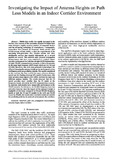| dc.contributor.author | Elmezughi, M. | |
| dc.contributor.author | Afullo, T. J. O. | |
| dc.contributor.author | Oyie, Nicholas O. | |
| dc.date.accessioned | 2021-04-20T09:28:43Z | |
| dc.date.available | 2021-04-20T09:28:43Z | |
| dc.date.issued | 2020-08 | |
| dc.identifier.citation | Conference: 2020 International Conference on Artificial Intelligence, Big Data, Computing and Data Communication Systems (icABCD) | en_US |
| dc.identifier.uri | https://ieeexplore.ieee.org/abstract/document/9183859 | |
| dc.identifier.uri | https://www.researchgate.net/publication/344063355_Investigating_the_Impact_of_Antenna_Heights_on_Path_Loss_Models_in_an_Indoor_Corridor_Environment | |
| dc.identifier.uri | http://hdl.handle.net/123456789/4594 | |
| dc.description.abstract | Mobile data traffic has rapidly increased in the last few years because of the continuous demand for higher data rates through a rapidly growing number of connected devices and the advancing technology of smartphones. Consequently, researchers have focused on frequency bands greater than 6 GHz because of their ability to meet the requirements of the upcoming fifth-generation (5G) wireless system, and other multimedia services that support high-speeds up to several gigabits per second. This research paper presents propagation measurements that have been conducted in a typical indoor corridor environment for both line-of-sight (LOS) and non-line-of-sight (NLOS) communication scenarios at three frequencies in the super high frequency (SHF) band, which are 14, 18, and 22 GHz. Moreover, this work aims primarily to investigate the effect of changing the antenna height on the performance of two well-known path loss prediction models. The models considered in this work are the close-in (CI) free space reference distance model and the floating-intercept (FI) model. Furthermore, this study presents mean square error (MSE) between the same and different antenna heights. The results observed that the CI model provides more stability than the FI model at the frequency bands selected in the LOS communication scenario. In contrast, both models have comparable performance in the NLOS scenario. Furthermore, the 22 GHz frequency band has attractive behavior since the impact of the antenna's height is negligible at this band compared to 14 and 18 GHz frequency bands at both the CI and FI models in the LOS and NLOS scenarios. Finally, the results show that both models are suitable for predicting path loss in enclosed environments like corridors. | en_US |
| dc.language.iso | en | en_US |
| dc.subject | mmWave, path loss, propagation measurements, antenna height, indoor corridor. | en_US |
| dc.title | Investigating the Impact of Antenna Heights on Path Loss Models in an Indoor Corridor Environment | en_US |
| dc.type | Article | en_US |

